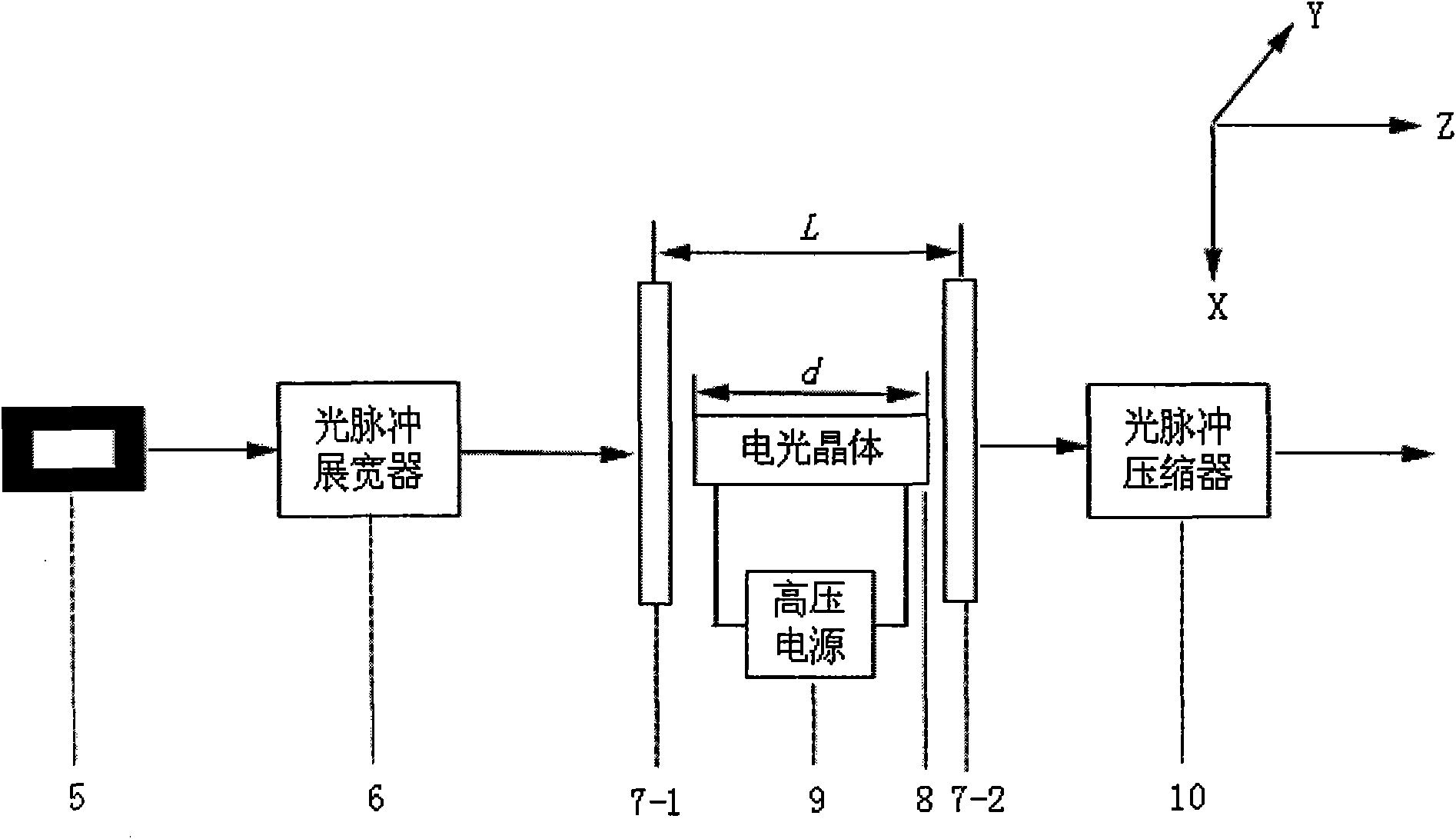Method for increasing signal to noise ratio of femtosecond laser through F-P (Fabry-Perol) etalon internally installed with electro-optic crystal
A femtosecond laser and electro-optic crystal technology, applied in lasers, laser components, circuits, etc., can solve the problems of complex optical path adjustment and low conversion efficiency, and achieve improved signal-to-noise ratio, convenient device adjustment, and high transmission efficiency Effect
- Summary
- Abstract
- Description
- Claims
- Application Information
AI Technical Summary
Problems solved by technology
Method used
Image
Examples
Embodiment 1
[0052] according to figure 2 Each optical element is installed, the facing surfaces of the first plate 7-1 and the second plate 7-2 of the F-P etalon are coated with a silver film with a reflectivity of 0.96, and the electro-optic crystal 8 is made of diduterium phosphate Potassium (KD * P) production, the length is 3cm, the electro-optic coefficient is 23.6×10 -12 V / m, distance ratio KD between two flat plates of F-P etalon * The length of P is 6 μm, and both the optical pulse stretcher 6 and the optical pulse compressor 10 adopt a grating pair composed of two antiparallel diffraction gratings, and the groove density of the diffraction grating is 600 lines / mm.
[0053] The femtosecond laser light source 5 adopts a titanium sapphire ultrashort pulse laser light source with a center wavelength of 800 nm, an initial pulse width of 50 fs, and a bandwidth of 18.7 nm. The relationship between the pulse width before and after the stretching of the chirped pulse can be represente...
Embodiment 2
[0058] In this example, the electro-optic crystal used in Example 1 is replaced by ammonium dihydrogen phosphate (ADP), and other conditions are the same as in Example 1. When the initial signal-to-noise ratio is 10 8 When the chirped pulse is injected into the F-P etalon with built-in ADP, by adjusting the high-voltage pulse power supply 9, the KD * The voltage V(t) on P varies in a linear form with a slope of -6308V / ns within the voltage range of 0-13kV, so as to be consistent with the chirp size of the chirped signal pulse, and the signal-to-noise ratio of the chirped pulse after spectral filtering About 3×10 10 , SNR Initial SNR 10 8 The improvement is about 300 times, that is, the signal-to-noise ratio is increased by 2 orders of magnitude, and the transmission efficiency of the chirped signal light can also be as high as 95%.
Embodiment 3
[0060] In this example, the electro-optic crystal used in Example 1 is replaced by potassium dihydrogen phosphate (KDP). The pulse stretcher 6 and the pulse compressor 10 all adopt a prism pair composed of two antiparallel prisms, and other conditions are the same as those in the implementation. Example 1 is the same, when the initial signal-to-noise ratio is 10 8 When the chirped pulse is injected into the F-P etalon with built-in ADP, by adjusting the high-voltage pulse power supply 9, the KD * The voltage V(t) on P varies in a linear form with a slope of -5160V / ns within the voltage range of 0-10kV, so as to be consistent with the chirp size of the chirped signal pulse, and the signal-to-noise ratio of the chirped pulse after spectral filtering About 3×10 10 , SNR Initial SNR 10 8 The improvement is about 300 times, that is, the signal-to-noise ratio is increased by 2 orders of magnitude, and the transmission efficiency of the chirped signal light can also be as high as 9...
PUM
 Login to View More
Login to View More Abstract
Description
Claims
Application Information
 Login to View More
Login to View More - R&D
- Intellectual Property
- Life Sciences
- Materials
- Tech Scout
- Unparalleled Data Quality
- Higher Quality Content
- 60% Fewer Hallucinations
Browse by: Latest US Patents, China's latest patents, Technical Efficacy Thesaurus, Application Domain, Technology Topic, Popular Technical Reports.
© 2025 PatSnap. All rights reserved.Legal|Privacy policy|Modern Slavery Act Transparency Statement|Sitemap|About US| Contact US: help@patsnap.com



